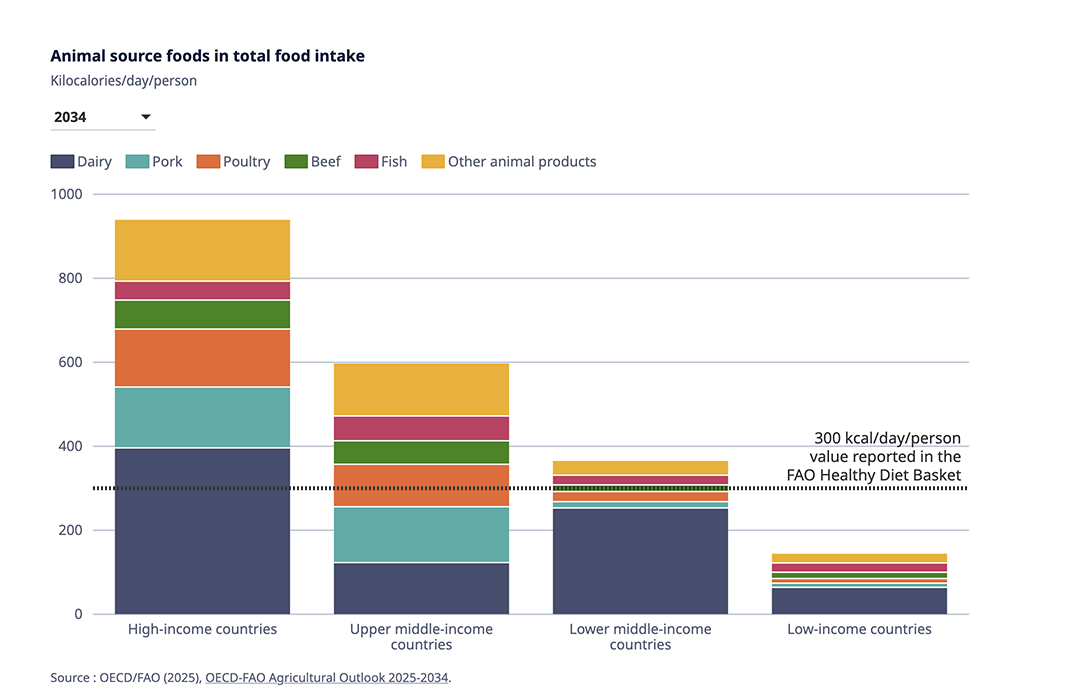2025-07-26
indicators

Rising incomes in middle-income countries are expected to lead to a significant increase in both consumption and production of animal-source foods over the coming decade, according to the OECD-FAO Agricultural Outlook 2025–2034. The report, jointly released by the Food and Agriculture Organization of the United Nations (FAO) and the Organisation for Economic Co-operation and Development (OECD), highlights the complex balance between improving nutrition and mitigating the environmental impacts of food production. The analysis forecasts that global per capita calorie intake from livestock and fish products will increase by 6% by 2034. This growth will be driven primarily by lower-middle-income countries, where consumption is expected to rise by 24%, nearly four times the global average. However, the benefits will remain unevenly distributed. In low-income countries, average daily intake of animal-source foods is projected at just 143 kilocalories per person, well below the 300-kilocalorie threshold the FAO considers a baseline for a healthy diet. The report underlines the need for greater investment in agricultural productivity to combat undernourishment and reduce the environmental footprint of food production. While the projected increase in nutrient-rich food consumption in developing nations is a positive sign for global nutrition, the report warns that productivity gains must be accelerated to ensure sustainable growth. OECD Secretary-General Mathias Cormann emphasized the importance of coordinated policy measures to maintain open global food markets while promoting innovation and sustainability in agriculture. FAO Director-General QU Dongyu echoed this sentiment, noting that current trends point to nutritional improvements for many, but that further progress is needed to support the most vulnerable populations and to lower the carbon intensity of food systems. Global production of agricultural and fish commodities is expected to grow by 14% through 2034, with the expansion largely enabled by productivity improvements in middle-income countries. This growth will include a 17% increase in meat, dairy, and egg output and a 7% rise in global livestock inventories. Although these trends will result in a 6% increase in direct agricultural greenhouse gas emissions, the emissions per unit of output are projected to decline, indicating improved carbon efficiency. Despite gains in efficiency, the report notes that declining real prices for agricultural commodities may pose difficulties for smallholder farmers, who often lack the resources to adopt new technologies. To address this, governments are encouraged to support innovation while ensuring that farmers have access to markets and tailored support. Scenario analysis within the report suggests that a 15% improvement in global agricultural productivity, coupled with the widespread use of emissions-reducing technologies, could eradicate undernourishment and lower direct GHG emissions by 7% compared to current levels. Technologies identified include precision agriculture, improved livestock feed, water and nutrient management systems, and practices such as crop rotation and intercropping. Trade will continue to play a critical role in the global food system, with 22% of all calories projected to cross international borders before being consumed. A rules-based multilateral trading framework will be essential to stabilizing prices and ensuring food availability across regions. The report also outlines key developments in crop and fuel production. Global cereal output is projected to grow at 1.1% annually, mainly through yield improvements. By 2034, 40% of cereals will be consumed as food, 33% as animal feed, and the remainder will go toward biofuels and industrial uses. Biofuel demand is expected to grow by 0.9% annually, with Brazil, India, and Indonesia leading this trend. Sub-Saharan Africa is identified as a region with strong potential for productivity growth, given its large cattle population and low per-animal output. Meanwhile, India and Southeast Asia are expected to account for 39% of global consumption growth by 2034. In contrast, China’s contribution to growth is projected to drop to 13%, down from 32% over the previous decade. In high-income countries, changing consumer preferences, public health policies, and concerns over diet-related diseases are expected to reduce per capita consumption of fats and sweeteners. Overall, the OECD-FAO report calls for sustained investment in agricultural innovation, stronger food systems, and international cooperation to address the dual challenges of improving global nutrition and reducing environmental impact.

